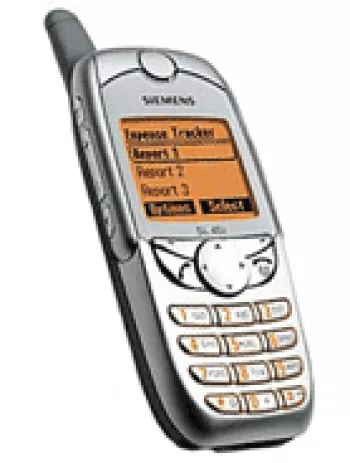
Overview and Historical Context
The Siemens M75 was launched in the first quarter of 2005, representing a time when mobile phone technology was undergoing significant transformations. Unlike today's smartphones, which are packed with multifunctional capabilities, the Siemens M75 was part of an era focused on transitioning from basic calling devices to more multifunctional feature phones. Its rugged design and practical functionalities made it a standout choice for users seeking durability and reliability. The device was discontinued later, reflecting the rapid advancements in mobile technology during that period.
Design and Build Quality
The physical dimensions of the M75, measuring 110.5 x 51.5 x 20.8 mm and weighing
110 grams, made it a solid and robust device. Its form factor was specifically
built to withstand tough conditions, making it appealing to users who required
durability over sleek aesthetics. With a volume of 104 cc, it offered a
substantial grip, avoiding any notion of fragility.
The phone was available in two color options: Safari Green and Volcano Black,
both attractive in their simplicity. Its rugged exterior was complemented by an
intuitive keypad, making button navigation straightforward.
Display and User Interface
The Siemens M75 came with a 1.9-inch TFT display, capable of showing 256K colors,
which was quite impressive for its time. The screen had a resolution of 132 x 176
pixels and a pixel density of approximately 116 ppi. While this may seem
minimalistic compared to modern standards, it was more than sufficient for basic
navigation and viewing photos.
The user interface revolved around simplicity and ease of use, with menus
explicitly designed for quick access to essential features like the phonebook,
messaging, and media.
Camera Capabilities
Incorporating a 1.3 MP main camera with video capabilities, the M75 allowed users
to capture photographs and record videos. This feature was seen as a luxurious
addition in mid-2000s feature phones, giving users a new appreciation for mobile
photography.
Although lacking in pixel density by current standards, it served the purpose for
capturing quick shots and memories on the go, adding value for everyday users.
Performance and Internal Specifications
The Siemens M75 was designed with a feature phone operating system, supporting a
basic yet effective user experience. With 14MB of internal storage and an RS-MMC
card slot capable of expansion, the device allowed adequate space for storing
contacts, media, and games.
The memory was supported by storage options, such as a 32 MB included card,
allowing enhanced functionality. However, the absence of significant RAM or
sophisticated processors reflects the technological limitations of the era.
Network and Connectivity
Siemens M75 supported GSM networks (900 / 1800 / 1900) and GPRS Class 10,
adequately covering basic connectivity needs. While the absence of EDGE, WLAN,
and 3G capabilities limited web-based applications, its Bluetooth 1.2 and
Infrared port allowed for device pairing and data transfer.
The device featured a proprietary USB connection and standard messaging
functions, including SMS, MMS, and email, accommodating essential communication
needs.
Battery Life
A removable Li-Ion 750 mAh battery powered the M75, promising a standby time of
up to 250 hours and a talk time of up to 5 hours. Given the limited power
consumption of feature phones compared to today’s smartphones, these parameters
ensured reliability and longevity.
The removable aspect of the battery allowed convenience for users, who could
carry spares and perform replacements with ease, extending the phone's life.
Multimedia and Entertainment
The M75 supported downloadable polyphonic, MP3, and AAC ringtones, enhancing its
multimedia provision. While lacking a loudspeaker and a 3.5mm jack limited its
audio output scope, it was equipped to make the most of its available technology.
It supported Java MIDP 2.0, widening its entertainment functions with available
downloadable games.
User Experience and Accessibility
The phonebook’s capability to store up to 1000 entries with photo caller ID
highlights Siemens’ approach to accessibility. Users could record 10 dialed,
received, and missed calls, making tracking communication simple.
Access to a WAP 2.0/xHTML browser allowed limited but effective web browsing,
which was a forward-thinking inclusion during its time.
Market Reception and Legacy
Upon release, the Siemens M75 received a positive reception for its robust design
and effective basic functionalities. For users who prioritized reliability and
simplicity, it stood out notably in a saturated market brimming with rapidly
evolving technologies.
Although later discontinued, the M75 is remembered as a significant device that
exemplified the transition phase between simplistic calling devices and modern
smartphones, contributing to the technological revolution in its own way.
Key Features of Siemens M75
- GSM 900 / 1800 / 1900 network support.
- Compact size with dimensions of 110.5 x 51.5 x 20.8 mm.
- Lightweight design weighing 110 g.
- TFT display with 256K colors for vivid visuals.
- Expandable memory with RS-MMC card slot, 32MB included.
- 1.3 MP main camera with video capabilities.
- Supports Bluetooth 1.2 for wireless connectivity.
- Infrared port available.
- Removable Li-Ion 750 mAh battery with up to 5 hours of talk time.
- Available in Safari Green and Volcano Black colors.
Siemens M75 Main Drawbacks
- Lacks EDGE support, limiting data speed to GPRS.
- Discontinued status, leading to limited support and parts availability.
- Relatively low screen-to-body ratio (approximately 19.6%).
- Low-resolution display with 116 ppi pixel density.
- Limited internal storage of 14MB, though expandable.
- No front-facing selfie camera.
- Absence of a loudspeaker and a 3.5mm audio jack, reducing audio options.
- No WLAN and GPS connectivity, limiting wireless networking capabilities.
- Lacks a built-in radio feature.
- Uses a proprietary USB port instead of standard ones.
- Relatively low battery capacity at 750 mAh, affecting usage time.





















View Also
More Phones
All Rights Reserved +14266 Phones © Mobilawy 2025

























